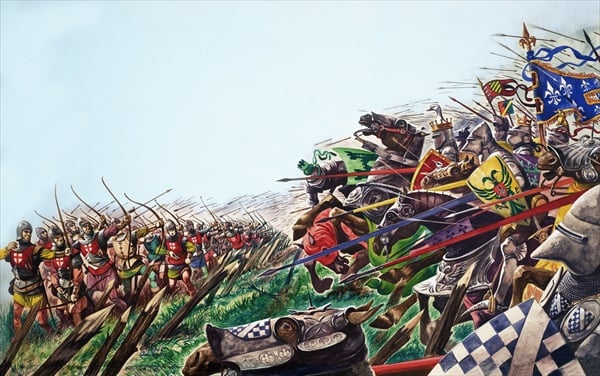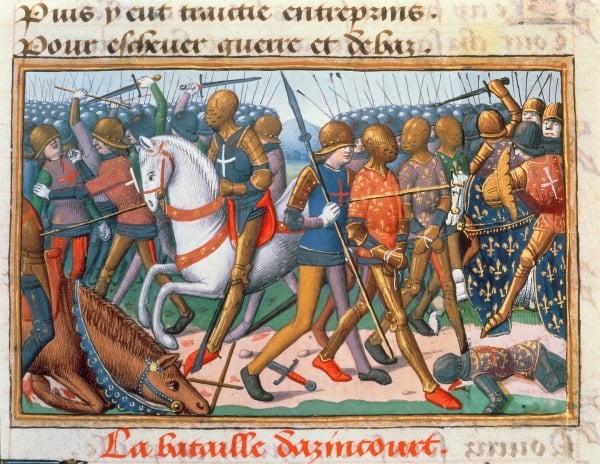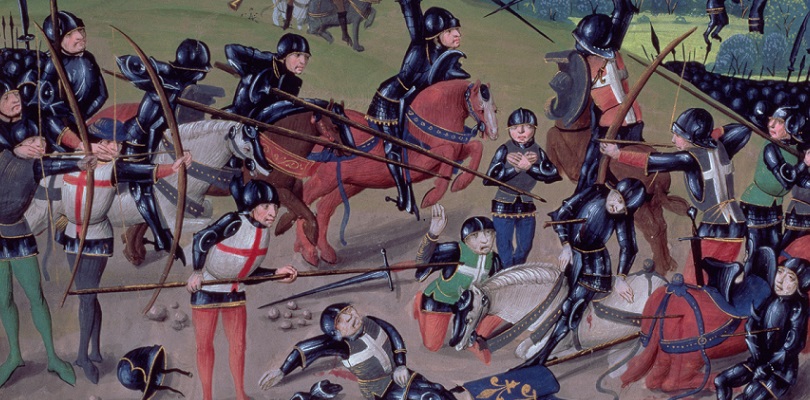
Band of Brothers: Henry V and the Battle of Agincourt
The English victory over the French at the Battle of Agincourt is the stuff of legend: the victory of a small, tired, weakened English army against the amassed ranks of soldiers-for-hire of the French forces played out on a muddy field in northern France. The forthcoming 600th anniversary of the battle will be commemorated with a series of events both in England and France, and to mark the jubilee, we have illustrated five facts about the battle with images from the Bridgeman collection.
The Hundred Years’ War
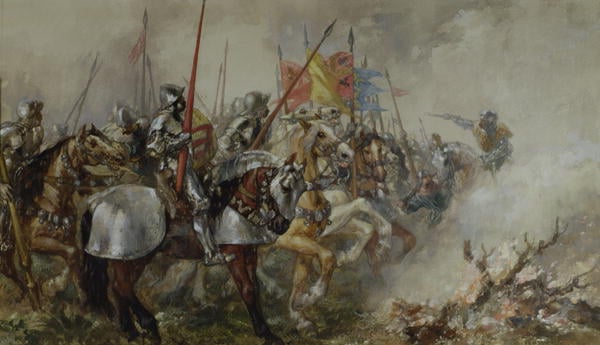
King Henry V at the Battle of Agincourt, 1415 by Sir John Gilbert, Atkinson Art Gallery, Southport, Lancashire
The Battle of Agincourt took place during the the Hundred Years’ War, a conflict which, despite its name, was neither one single war nor did it last one hundred years. Its origins can be traced back to 1066 and William the Conqueror. William was not only King of England, but also Duke of Normandy, a vassal of the French king. To be both a king and a servant was destined to cause tension, tension which found its release in 1337 when Edward III, faced with the threat of a new alliance between England’s neighbours France and Scotland, refused to pay homage to Philip VI of France, claiming the French crown for himself as the grandson of Philip IV. This began the first ‘Edwardian’ phase of a war that would stretch, with intermittent periods of strained peace, for 116 years until the French emerged victorious in 1453. The Battle of Agincourt took place on Friday, 25 October 1415 beginning the third, ‘Lancastrian’, phase of the war, with Henry V‘s entrance into Normandy to revive the claim of his great-grandfather Edward III to the French throne.
David versus Goliath
Despite seven contemporary accounts of the battle, three of which are from eyewitnesses to the fighting itself, the exact number of combatants on both sides remains uncertain and has been the subject of centuries-old disagreement between historians. What is certain is that Henry’s soldiers went into the battle at a distinct disadvantage: the English first captured Harfleur, where an outbreak of dysentery killed many of Henry’s men and weakened the rest. The French army was larger and better equipped, but they were also disorganised and crowded on the small battlefield, freshly ploughed farmland which had turned to deep mud after torrential rain the night before. French soldiers, with their heavy full-plate armour, had to trudge through sludge towards the enemy, tiring themselves before any actual fighting.
Henry borrowed a technique used by the Turkish in the Battle of Nicopolis nineteen years earlier: he had his soldiers fashion wooden stakes, each six foot in length, which were buried in the mud of the battlefield, protecting the English archers and impaling any French cavalry, as can be seen in the illustration above. Nevertheless the French were so sure of victory that the nobles insisted on riding on ahead and, when Henry’s longbowmen and archers released a barrage of arrows, the arrows not only maimed French footsoldiers but also hurt and frightened the horses, many of whom bolted riderless through the French ranks, killing many more soldiers in their wake.
Henry V: War criminal?
The Agincourt Carol, written not long after the battle, praises the king for his “grace and myght of chyvalry”. However, Henry’s decision to kill a large number of French prisoners-of-war was contentious, even to many of his contemporaries, and is seen by some as being the end of chivalry in warfare, so much so that in 2010 the Shakespeare Theatre Company in Washington, D.C. hosted a mock trial headed by Supreme Court Justices Samuel Alito and Ruth Bader Ginsburg, who found Henry V guilty of war crimes. Why did Henry kill so many of the French prisoners?
After the battle, with his soldiers victorious but weakened by dysentery and with rumours of further French reinforcements on their way, Henry had to make a choice: keep all 1,000 prisoners of war alive and risk an uprising, or kill 100 of them, reducing the numbers and frightening the survivors. Henry chose the latter option and it worked: the remaining prisoners were so shocked by the unexpected slaughter of their compatriots, they did not attempt to escape or rebel and Henry returned to England with subdued prisoners whom he could use as bargaining chips in future negotiations with the French.
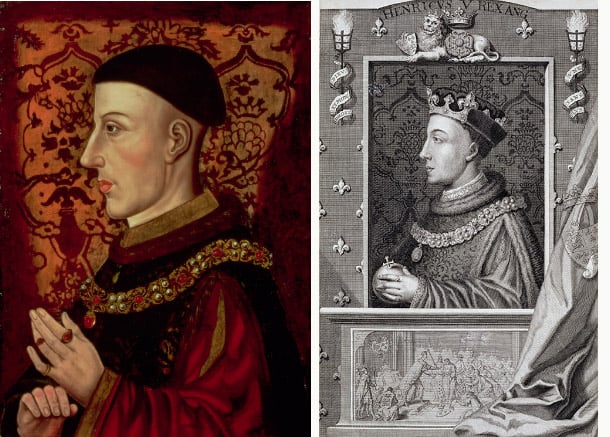
Left: Portrait of Henry V (1387-1422) (oil on panel) (see 106922), English School, (15th century) / National Portrait Gallery, London, UK / Bridgeman Images
Right: Henry V (1387-1422), after a painting in Kensington Palace (detail of the engraving), Vertue, George (1684-1756) / Private Collection / The Stapleton Collection / Bridgeman Images
Portraits of the king, such as the one now in The National Portrait Gallery and much copied and disseminated in his lifetime, show him in profile, his right side hidden from view. This is because in 1503, during the Battle of Shrewsbury, an arrow hit Henry in the face, burying itself six inches into his right cheek. During Agincourt Henry was maimed again, sustaining an axe blow to his face. Although Henry was barely 28 at the time of the battle and had only been on the throne for two years, he was a proven military leader, ready not only to take physical beatings but also make unpopular decisions for the sake of his military campaign.
A brief victory
Although Agincourt was undoubtedly a great victory for the English over the French, within forty years the gains made by the English had been lost: French spirits were raised by the appearance of Joan of Arc and her messages from God promising victory. That victory came at the Battle of Castillon in 1453 which ended the Hundred Years’ War and saw the English reduced in France to a presence in Calais and the Channel Islands.
Henry died seven years after the Battle of Agincourt, but the goodwill towards him following the victory allowed the king great control over his parliament upon his return to England and he was able to effect one of the most intense bouts of taxation ever experienced. In 1421, Henry’s brother, Thomas of Lancaster was defeated by a Franco-Scottish army and killed at the Battle of Baugé. Henry travelled to France in an attempt to recapture territory and died in Vincennes possibly from dysentery contracted during the otherwise successful siege of Meaux.
We few, we happy few
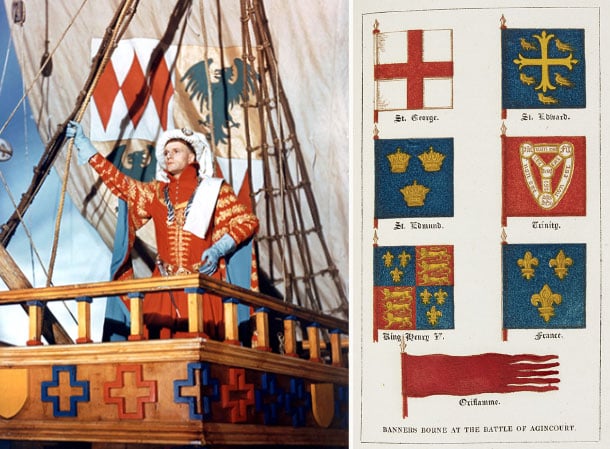
Left: Laurence Olivier in ‘Henry V’, 1944 / Private Collection / Photo © DILTZ / Bridgeman Images
Right: Banners borne at the Battle of Agincourt, illustration from ‘The History of Agincourt; and of the expedition of Henry the Fifth into France…/ British Library, London, UK / Bridgeman Images
No exact record exists of the speech that Henry gave to rally his men before the battle but the words that Shakespeare gives to Henry in the “St Crispin’s Day Speech” have certainly contributed to the fame, legend and popularity of Henry V and Agincourt. At the 500th anniversary of the battle in 1915, the British were fighting the German Empire on the Western Front at the Battle of Loos and The Times reprinted the text of the Shakespeare speech in one of its editorials. Laurence Olivier’s stirring radio broadcasts of Shakespearean monologues during the Second World War elicited a request from the Prime Minister, Winston Churchill, to film Henry V to boost morale, and the speech has been repeated, paraphrased and used as inspiration in everything from Braveheart to Buffy the Vampire Slayer, ensuring, just as Henry V himself says in Shakespeare’s play, that the Englishmen who fought at Agincourt will never be forgotten:
And Crispin Crispian shall ne’er go by,
From this day to the ending of the world,
But we in it shall be remembered
Find out more
See more images of Battle of Agincourt. Contact uksales@bridgemanimages.com for more information regarding licensing, reproduction and copyright.
More on the blog: Battles of World War I: Land, Sea and Air Engagements

